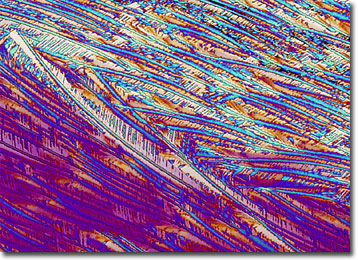Polarized Light Microscopy Digital Image Gallery
DDI (2',3'-Dideoxyinosine)
Marketed in North America under the trade name Videx, 2',3'-dideoxyinosine, or DDI, is frequently utilized in the treatment of the human immunodeficiency virus (HIV) and the related acquired immune deficiency syndrome (AIDS). The pharmaceutical is associated with potentially very serious side effects, however, and was originally only prescribed after AZT-based therapy began to lose its effectiveness.

DDI is a synthetic purine nucleoside that acts as a reverse transcriptase inhibitor. As such, the drug may prevent further reproduction of HIV viral cells, but does not affect existing cells. Studies indicate that DDI may also cause an increase in the number of CD4 helper white blood cells in the body, functioning to counteract the depressed counts associated with advanced stages of HIV. However, due to the severe nature of some side effects associated with the drug, when the United States Food and Drug Administration (FDA) initially approved DDI for the treatment of HIV/AIDS in 1991, it was designated solely for use after prolonged AZT treatments. Yet, in recent years, the FDA has approved DDI as a vanguard therapy that can be utilized early on in HIV/AIDS treatments.
The most dangerous side effects of DDI consumption include pancreatitis, or inflammation of the pancreas, and severe liver problems. Both of these conditions can be fatal and, therefore, patients utilizing DDI therapy should carefully watch for their symptoms, reporting any problems immediately to their physician or health care provider. Many symptoms of pancreaitis and liver damage are essentially the same, including nausea, vomiting, and abdominal pain. Liver problems are, however, also usually accompanied by a yellowing of the skin or eyes. Other side effects of DDI consumption may include headache, itching, rash, weakness, dry mouth, dry eyes, and numbness or burning sensations in the extremities of the body.
